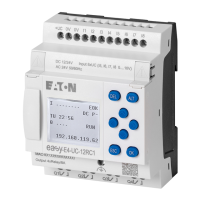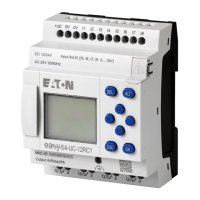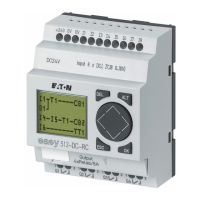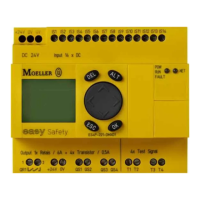List of Figures
Fig. 332: API key 738
Fig. 333: Web client 738
Fig. 334: e-mail tab 741
Fig. 335: Email tab with the settings from the example 745
Fig. 336: Ethernet tab with settings from the example 746
Fig. 337: Email example when the operating mode changes 747
Fig. 338: Alarm function block tab with parameters from the example and
FBD program with alarm function block and P button P01 749
Fig. 339: Example email when triggered by alarm function block AL01 750
Fig. 340: Example showing an easyE4 control relay with I/O expansions and
an easy communication module EASY-COM-SWD-… 753
Fig. 341: Device model with 2SU 755
Fig. 342: EASY-COM-SWD-…Connecting the power supply 757
Fig. 343: Connecting EASY-COM-SWD-… 759
Fig. 344: Work pane with base device and communication module; catalog
expanded with "SWD" tab 763
Fig. 345: General diagram: The easyE4, set up as a Modbus RTU master,
communicates with the devices set up as Modbus RTU slaves (DE1, DC1,
DG1, DA1, easyE4, and others) 765
Fig. 346: Versions 767
Fig. 347: Connecting EASY-COM-RTU-… outputs 769
Fig. 348: Connecting the EASY-COM-RTU-… power supply 770
Fig. 349: Work pane with base device and EASY-COM-RTU-M1 master com-
munication module 773
Fig. 350: A single easyE4 functioning as a Modbus TCP server handling two
Modbus TCP clients 776
Fig. 351: One easyE4 functioning as a Modbus TCP client controlling four
Modbus TCP servers 777
Fig. 352: Work pane with base device and Modbus TCP server module 778
Fig. 353: Device information tab 779
Fig. 354: Expansion parameter tab for Modbus TCP servers 779
Fig. 355: Address range addressing: 782
Fig. 356: Cyclical data tab with sample function codes that have been con-
figured and added range boxes 783
Fig. 357: Overview of cyclical data function codes 786
866
easyE402/24 MN050009ENEaton.com

